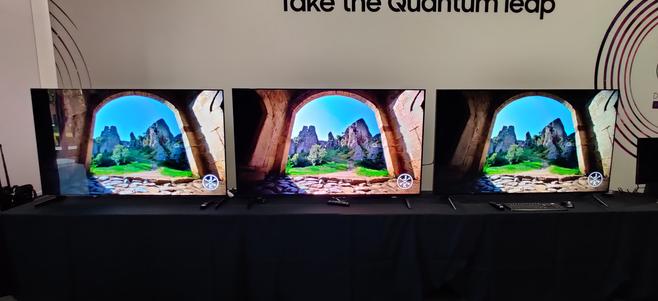Samsung Display has an impressive screen to show off at CES — a 4K panel that melds OLED technology with the company’s Quantum Dot material to produce colors that can outshine rival TVs and monitors.
The technology is called “QD-Display,” and it marks the company’s latest effort to top the OLED panels from rival LG. OLED screens are known for offering vibrant colors and pure blacks, and Samsung says its QD-Display can offer even higher color quality and brightness, not to mention pure blacks, a key improvement over Samsung’s QLED TVs.
(L-R) LG G1 OLED, Samsung QD-Display, LG QNED90 mini LED TV(Photo: Michael Kan)Last month, we checked out the QD-Display technology at Samsung's offices in San Jose, and came away impressed. The company demoed the new panel by placing it next to two 4K TVs from LG, one built with an OLED panel, the other with mini LEDs.
Initially, we noticed little difference. That’s because all three 65-inch TVs offered top-notch visuals. However, Samsung’s product began to stand out once we spotted the technology squeezing out more light and richer details across the televised images.
For example, neon colored signs and lamp posts popped out with brightness. Meanwhile, background details such as brick walls and hair carried more light and reflections. In the images below, you'll notice the fuller colors on Samsung's QD-Display (pictured right)
LG's G1 OLED TV (left) Samsung's QD-Display (right)(Photos: Michael Kan)Although the improvements were subtle, the enhanced details added up, creating life-like images compared to the flatter, faded visuals found on LG’s display technology.
The contrast was even more stark when Samsung’s QD-Display panel was compared to an LCD-powered IPS PC monitor from LG.
LG IPS monitor (left) and Samsung QD-Display monitor (right)(Photo: Michael Kan)
The QD-Display was able to beam pure blacks that made images look stunning when playing a PC game in a dark room. The IPS monitor, on the other hand, could only display ghostly grays when trying to emit black.
(Photo: Michael Kan)The QD-Display works by leveraging a new kind of OLED panel that uses blue light, instead of white light, to create colors. According to Samsung, a key drawback with rival OLED technology is how it struggles to emit saturated bright colors from a white light source.
Blue light, on other hand, can efficiently beam through Samsung’s Quantum Dot layer — a microscopic crystal semiconductor material — to create the color spectrum. Because blue has a high energy frequency, the Quantum Dot layer can easily convert the light into red and green colors, which have lower energy frequencies.
The layers on Samsung's QD-Display(Photo: Michael Kan)"We're not doing any filtering. Almost all the energy hitting the Quantum Dot is usually converted. Not the whole thing, but it's a very high number. And that creates better light efficiency," said Chirag Shah, Samsung Display's director of Quantum Dot technology.
The pixels on the screen are also different from rival OLED panels. "We use a true RGB pixel rather than a white plus RGB pixel," Shah added.
According to Samsung, the white pixel can be problematic; although it can boost a color's brightness, it can also blur the vibrancy, downgrading the color accuracy. In contrast, the QD-Display can avoid any color contamination by relying on a pure RGB pixel, which can emit the various colors across the spectrum.
How the pixels look on the screen(Photo: Michael Kan)"QD-Display provides almost two times the color volume of even the most recent white OLEDs," Shah added. "And that means you not only get more color, you get more thrills, more emotions out of the images that you're seeing on the screen."
The other benefit to Samsung's blue light OLED is a higher peak brightness at over 1,500 nits on a TV. But if you're worried about overexposure to blue light, Shah says don't worry; the company optimized the QD-Display technology to reduce harmful blue light over the TV's default setting.
Recommended by Our Editors
The Best TVs for GamingOLED vs. QLED: What's the Difference?The Best 75-Inch (and up) TVs for 2022"Unlike other technologies where you have to activate the low blue light feature, which often results in color deterioration or a yellowish fade on the screen, this one you get all the colors, all the color volume, the HDR, without any compromise," he said.
Wide viewing angles(Photo: Michael Kan)The QD-Display technology also offers wide viewing angles, without any noticeable drop in image quality. The TV version of the panel can also be quite thin.
On the downside, the technology can experience burn-in problems, although Samsung says the panel should do a better job of mitigating the issue than other OLED panels.
QD-Display side view(Photo: Michael Kan)The newly announced QD-Display technology will power 65- and 55-inch TVs and 34-inch PC monitors in the coming months from brands including Samsung Electronics and Dell’s Alienware. The TVs will be capable of a 144Hz frame rate while the monitors can support up to 175Hz.
However, the companies may settle on a different naming scheme when it comes to promoting the new technology inside. So don't be surprised if a TV or monitor maker drops the QD-Display branding for something else.
Pricing wasn't revealed, but we're not talking about $20,000 sets, according to Samsung Display. Instead, pricing will be comparable to a premium 4K TV or PC monitor, which can cost closer to $2,000. Samsung also expects the pricing to go down as the technology matures.
Get Our Best Stories!
Sign up for What's New Now to get our top stories delivered to your inbox every morning.
This newsletter may contain advertising, deals, or affiliate links. Subscribing to a newsletter indicates your consent to our Terms of Use and Privacy Policy. You may unsubscribe from the newsletters at any time.
Thanks for signing up!Your subscription has been confirmed. Keep an eye on your inbox!
Sign up for other newsletters



